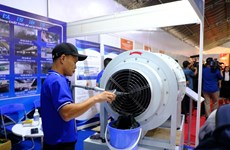WB: Vietnam’s economy becomes more stable
Vietnam ’s economy is gradually entering a more stable macroeconomic
environment after a prolonged period of heightened turbulence, said a
World Bank report.
At a press conference to announce the World Bank’s East Asia-Pacific Economic Update 2012 in Hanoi on May 23, the chief economic expert of the WB in Vietnam, Deepak Mishra said while Vietnam’s economy has started to stabilise, the significant tightening of macroeconomic policies, along with an uncertain global economic environment, are beginning to take a toll on economic growth.
At a press conference to announce the World Bank’s East Asia-Pacific Economic Update 2012 in Hanoi on May 23, the chief economic expert of the WB in Vietnam, Deepak Mishra said while Vietnam’s economy has started to stabilise, the significant tightening of macroeconomic policies, along with an uncertain global economic environment, are beginning to take a toll on economic growth.
Vietnam ’s economy is gradually entering a more stable macroeconomic
environment after a prolonged period of heightened turbulence, said a
World Bank report.
At a press conference to announce the World Bank’s East Asia-Pacific Economic Update 2012 in Hanoi on May 23, the chief economic expert of the WB in Vietnam, Deepak Mishra said while Vietnam’s economy has started to stabilise, the significant tightening of macroeconomic policies, along with an uncertain global economic environment, are beginning to take a toll on economic growth.
The country’s real GDP growth decelerated from 6.8 percent in 2010 to 5.9 percent in 2011 and further to 4.0 percent in the first quarter of 2012, he said.
According to the report, tighter domestic policies in 2011 have dampened investment, particularly in infrastructure and real estate, and private consumption. Thanks to a combination of these measures and falling food prices, inflation declined to 10.5 percent year-on-year in April, 2012 from a peak of 23 percent in August, 2011.
Maintaining macroeconomic stability remains the Vietnamese Government’s priority. The country’s economic growth is expected to be around 5.7 percent, and year-end inflation is forecast to decline to below 10 percent in 2012.
In a move to shore up the economy, the State Bank of Vietnam reduced policy interest rates by 200 basis points in March and April from 15 to 13 percent, and announced further reductions of at least 100 basis points every quarter during 2012, the report said.
Cooling demand and slow credit growth should dampen the inflationary impact of the rate cuts, which at the same time should help ease financing costs for the private sector.
The report also said that Vietnam ’s public debt is likely to remain sustainable if economic recovery continues and authorities remain on the current path of fiscal consolidation.
Deepak Mishra pointed out that Vietnam ’s near-term policy challenge is to maintain macroeconomic stability and restore confidence among investors, while addressing longer-term structural reforms.
He noted that the Government is stepping up efforts to restructure small and medium-sized enterprises (SME), public investment management and the financial sector.
A number of key regulations, including those involving medium-term investment planning, management and supervision of State capital investment in SOE, and performance monitoring of SOE are likely to be enacted during 2012.
Even if only a subset of the announced structural reforms is implemented steadfastly, Vietnam should return to a more sustainable macroeconomic environment while laying the foundations for greater efficiency and productivity to drive medium and long-term growth, he said.
The WB report also indicated that growth remains strong in developing East Asia and Pacific, recording 8.2 percent in 2011, although it has slowed from its post-crisis peaks.
In 2012, East Asia will remain the strongest performing region, even though its annual growth will further moderate as a result of a continued weak external environment.
The region is projected to grow by 7.6 percent this year, with slower expansion in China pulling down much of the regional aggregate.-VNA
At a press conference to announce the World Bank’s East Asia-Pacific Economic Update 2012 in Hanoi on May 23, the chief economic expert of the WB in Vietnam, Deepak Mishra said while Vietnam’s economy has started to stabilise, the significant tightening of macroeconomic policies, along with an uncertain global economic environment, are beginning to take a toll on economic growth.
The country’s real GDP growth decelerated from 6.8 percent in 2010 to 5.9 percent in 2011 and further to 4.0 percent in the first quarter of 2012, he said.
According to the report, tighter domestic policies in 2011 have dampened investment, particularly in infrastructure and real estate, and private consumption. Thanks to a combination of these measures and falling food prices, inflation declined to 10.5 percent year-on-year in April, 2012 from a peak of 23 percent in August, 2011.
Maintaining macroeconomic stability remains the Vietnamese Government’s priority. The country’s economic growth is expected to be around 5.7 percent, and year-end inflation is forecast to decline to below 10 percent in 2012.
In a move to shore up the economy, the State Bank of Vietnam reduced policy interest rates by 200 basis points in March and April from 15 to 13 percent, and announced further reductions of at least 100 basis points every quarter during 2012, the report said.
Cooling demand and slow credit growth should dampen the inflationary impact of the rate cuts, which at the same time should help ease financing costs for the private sector.
The report also said that Vietnam ’s public debt is likely to remain sustainable if economic recovery continues and authorities remain on the current path of fiscal consolidation.
Deepak Mishra pointed out that Vietnam ’s near-term policy challenge is to maintain macroeconomic stability and restore confidence among investors, while addressing longer-term structural reforms.
He noted that the Government is stepping up efforts to restructure small and medium-sized enterprises (SME), public investment management and the financial sector.
A number of key regulations, including those involving medium-term investment planning, management and supervision of State capital investment in SOE, and performance monitoring of SOE are likely to be enacted during 2012.
Even if only a subset of the announced structural reforms is implemented steadfastly, Vietnam should return to a more sustainable macroeconomic environment while laying the foundations for greater efficiency and productivity to drive medium and long-term growth, he said.
The WB report also indicated that growth remains strong in developing East Asia and Pacific, recording 8.2 percent in 2011, although it has slowed from its post-crisis peaks.
In 2012, East Asia will remain the strongest performing region, even though its annual growth will further moderate as a result of a continued weak external environment.
The region is projected to grow by 7.6 percent this year, with slower expansion in China pulling down much of the regional aggregate.-VNA













